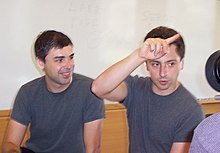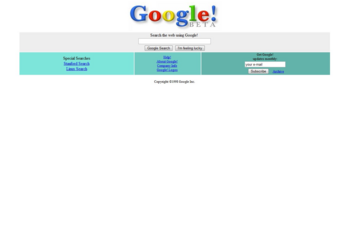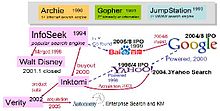Early history
Google began in March 1998 as a research project by Larry Page and Sergey Brin, Ph.D.students at Stanford working on the Stanford Digital Library Project (SDLP). The SDLP's goal was “to develop the enabling technologies for a single, integrated and universal digital library." and was funded through the National Science Foundation among other federal agencies.[2][3][4][5] In search for a dissertation theme, Page considered—among other things—exploring the mathematical properties of the World Wide Web, understanding its link structure as a hugegraph. His supervisor Terry Winograd encouraged him to pick this idea (which Page later recalled as "the best advice I ever got") and Page focused on the problem of finding out which web pages link to a given page, considering the number and nature of such backlinks to be valuable information about that page (with the role of citations in academic publishing in mind). In his research project, nicknamed "BackRub", he was soon joined by Sergey Brin, a fellow Stanford Ph.D. student supported by a National Science Foundation Graduate Fellowship. Brin was already a close friend, whom Page had first met in the summer of 1995 in a group of potential new students which Brin had volunteered to show around the campus. Page's web crawler began exploring the web in March 1996, setting out from Page's own Stanford home page as its only starting point. To convert the backlink data that it gathered into a measure of importance for a given web page, Brin and Page developed the PageRank algorithm. Analyzing BackRub's output—which, for a given URL, consisted of a list of backlinks ranked by importance—it occurred to them that a search engine based on PageRank would produce better results than existing techniques (existing search engines at the time essentially ranked results according to how many times the search term appeared on a page).
A small search engine called "RankDex" from IDD Information Services (a subsidiary of Dow Jones) designed by Robin Li was, since 1996, already exploring a similar strategy for site-scoring and page ranking. The technology in RankDex would be patented and used later when Li founded Baidu in China.
Convinced that the pages with the most links to them from other highly relevant Web pages must be the most relevant pages associated with the search, Page and Brin tested their thesis as part of their studies, and laid the foundation for their search engine. By early 1997, the backrub page described the state as follows:
Some Rough Statistics (from August 29th, 1996)
Total indexable HTML urls: 75.2306 Million
Total content downloaded: 207.022 gigabytes
...BackRub is written in Java and Python and runs on several Sun Ultras and Intel Pentiums running Linux. The primary database is kept on an Sun Ultra II with 28GB of disk. Scott Hassan and Alan Steremberg have provided a great deal of very talented implementation help. Sergey Brin has also been very involved and deserves many thanks.-Larry Page page@cs.stanford.edu
Originally the search engine used the Stanford website with the domain google.stanford.edu. The domain google.com was registered on September 15, 1997. They formally incorporated their company, Google Inc., on September 4, 1998 at a friend's garage in Menlo Park, California.
Both Brin and Page had been against using advertising pop-ups in a search engine, or an "advertising funded search engines" model, and they wrote a research paper in 1998 on the topic while still students. However, they soon changed their minds and early on allowed simple text ads.
The name "Google" originated from a misspelling of "googol," which refers to the number represented by a 1 followed by one-hundred zeros (although Enid Blyton used the phrase "Google Bun" in The Magic Faraway Tree (published 1941), The Folk of the Faraway Tree(published 1946),and called a clown character "Google" in Circus Days Again (published 1942), and there is also the Googleplex Star Thinker from Douglas Adams' The Hitchhiker's Guide to the Galaxy). Having found its way increasingly into everyday language, the verb, "google," was added to the Merriam Webster Collegiate Dictionary and the Oxford English Dictionary in 2006, meaning, "to use the Google search engine to obtain information on the Internet." The use of the term itself reflects their mission to organize a seemingly infinite amount of information on the web.
By the end of 1998, Google had an index of about 60 million pages. The home page was still marked "BETA", but an article in Salon.com already argued that Google's search results were better than those of competitors like Hotbot or Excite.com, and praised it for being more technologically innovative than the overloaded portal sites (like Yahoo!, Excite.com, Lycos, Netscape's Netcenter, AOL.com, Go.com and MSN.com) which at that time, during the growing dot-com bubble, were seen as "the future of the Web", especially by stock market investors.
In March 1999, the company moved into offices at 165 University Avenue inPalo Alto, home to several other noted Silicon Valley technology startups. After quickly outgrowing two other sites, the company leased a complex of buildings in Mountain View at 1600 Amphitheatre Parkway fromSilicon Graphics (SGI) in 2003. The company has remained at this location ever since, and the complex has since become known as theGoogleplex (a play on the word googolplex, a number that is equal to 1 followed by a googol of zeros). In 2006, Google bought the property from SGI for $319 million.
The Google search engine attracted a loyal following among the growing number of Internet users, who liked its simple design. In 2000, Google began selling advertisements associated with search keywords. The ads were text-based to maintain an uncluttered page design and to maximize page loading speed. Keywords were sold based on a combination of price bid and click-throughs, with bidding starting at $.05 per click. This model of selling keyword advertising was pioneered by Goto.com (later renamed Overture Services, before being acquired by Yahoo! and rebranded as Yahoo! Search Marketing).[26][27][28] While many of its dot-com rivals failed in the new Internet marketplace, Google quietly rose in stature while generating revenue.
Google's declared code of conduct is "Don't be evil", a phrase which they went so far as to include in their prospectus (aka "S-1") for their 2004 IPO, noting, "We believe strongly that in the long term, we will be better served — as shareholders and in all other ways — by a company that does good things for the world even if we forgo some short term gains."[29]
Growth
In February 2003, Google acquired Pyra Labs, owner of Blogger, a pioneering and leading web loghosting website. Some analysts considered the acquisition inconsistent with Google's business model. However, the acquisition secured the company's competitive ability to use information gleaned from blog postings to improve the speed and relevance of articles contained in a companion product to the search engine Google News.
At its peak in early 2004, Google handled upwards of 84.7% of all search requests on the World Wide Web through its website and through its partnerships with other Internet clients like Yahoo!,AOL, and CNN. In February 2004, Yahoo! dropped its partnership with Google, providing an independent search engine of its own. This cost Google some market share, yet Yahoo!'s move highlighted Google's own distinctiveness, and today the verb "to google" has entered a number of languages (first as a slang verb and now as a standard word), meaning, "to perform a web search" (a possible indication of "Google" becoming a genericized trademark).
Analysts speculate that Google's response to its separation from Yahoo! will be to continue to make technical and visual enhancements to personalized searches, using the personal data that is gathering from orkut, Gmail, and Google Product Search to produce unique results based on the user. Frequently, new Google enhancements or products appear in its inventory. Google Labs, the experimental section of Google.com, helps Google maximize its relationships with its users by including them in the beta development, design and testing stages of new products and enhancements of already existing ones.[38]
After the IPO, Google's stock market capitalization rose greatly and the stock price more than quadrupled. On August 19, 2004 the number of shares outstanding was 172.85 million while the "free float" was 19.60 million (which makes 89% held by insiders). In January 2005 the number of shares outstanding was up 100 million to 273.42 million, 53% of that was held by insiders, which made the float 127.70 million (up 110 million shares from the first trading day). The two founders are said to hold almost 30% of the outstanding shares. The actual voting power of the insiders is much higher, however, as Google has a dual class stock structure in which each Class B share gets ten votes compared to each Class A share getting one. Page says in the prospectus that Google has, "a dual class structure that is biased toward stability and independence and that requires investors to bet on the team, especially Sergey and me." The company has not reported any treasury stock holdings as of the Q3 2004 report.
On June 1, 2005, Google shares gained nearly four percent after Credit Suisse First Boston raised its price target on the stock to $350. On that same day, rumors circulated in the financial community that Google would soon be included in the S&P 500.[39] When companies are first listed on the S&P 500 they typically experience a bump in share price due to the rapid accumulation of the stock within index funds that track the S&P 500. The rumors, however, were premature and Google was not added to the S&P 500 until 2006. Nevertheless, on June 7, 2005, Google was valued at nearly $52 billion, making it one of the world's biggest media companies by stock market value.
On August 18, 2005 (one year after the initial IPO), Google announced that it would sell 14,159,265 (another mathematical reference as π ≈ 3.14159265) more shares of its stock to raise money. The move would double Google's cash stockpile to $7 billion. Google said it would use the money for "acquisitions of complementary businesses, technologies or other assets".[40]
On September 28, 2005, Google announced a long-term research partnership with NASA which would involve Google building a 1,000,000-square-foot (93,000 m2) R&D center at NASA's Ames Research Center, and on December 31, 2005 Time Warner's AOL unit and Google unveiled an expanded partnership—see Partnerships below.
Additionally in 2005, Google formed a partnership with Sun Microsystems to help share and distribute each other's technologies. As part of the partnership Google will hire employees to help in the open source office program OpenOffice.org.[41]
With Google's increased size comes more competition from large mainstream technology companies. One such example is the rivalry between Microsoft and Google.[42] Microsoft has been touting its Bing search engine to counter Google's competitive position. Furthermore, the two companies are increasingly offering overlapping services, such as webmail (Gmail vs. Hotmail), search (both online and local desktop searching), and other applications (for example, Microsoft's Windows Live Local competes with Google Earth). In addition to an Internet Explorer replacement Google is designing its own Linux-based operating system called Chrome OS to directly compete with Microsoft Windows. There were also rumors of a Google web browser, fueled much by the fact that Google is the owner of the domain name"gbrowser.com". These were later proven when Google released Google Chrome. This corporate feud is most directly expressed in hiring offers and defections. Many Microsoft employees who worked on Internet Explorer have left to work for Google. This feud boiled over into the courts when Kai-Fu Lee, a former vice-president of Microsoft, quit Microsoft to work for Google. Microsoft sued to stop his move by citing Lee's non-compete contract (he had access to much sensitive information regarding Microsoft's plans in China).
Google and Microsoft reached a settlement out of court on 22 December 2005, the terms of which are confidential.[43]
Click fraud has also become a growing problem for Google's business strategy. Google's CFO George Reyes said in a December 2004 investor conference that "something has to be done about this really, really quickly, because I think, potentially, it threatens our business model."[44] Some have suggested that Google is not doing enough to combat click fraud. Jessie Stricchiola, president of Alchemist Media, called Google, "the most stubborn and the least willing to cooperate with advertisers", when it comes to click fraud.
While the company's primary market is in the web content arena, Google has also recently began to experiment with other markets, such as radio and print publications. On January 17, 2006, Google announced that it had purchased the radio advertising company dMarc, which provides an automated system that allows companies to advertise on the radio.[45] This will allow Google to combine two advertising media—the Internet and radio—with Google's ability to laser-focus on the tastes of consumers. Google has also begun an experiment in selling advertisements from its advertisers in offline newspapers and magazines, with select advertisements in the Chicago Sun-Times.[46] They have been filling unsold space in the newspaper that would have normally been used for in-house advertisements.
During the third quarter 2005 Google Conference Call, Eric Schmidt said, "We don't do the same thing as everyone else does. And so if you try to predict our product strategy by simply saying well so and so has this and Google will do the same thing, it's almost always the wrong answer. We look at markets as they exist and we assume they are pretty well served by their existing players. We try to see new problems and new markets using the technology that others use and we build."
After months of speculation, Google was added to the Standard & Poor's 500 index (S&P 500) on March 31, 2006.[47] Google replacedBurlington Resources, a major oil producer based in Houston that had been acquired by ConocoPhillips.[48] The day after the announcement Google's share price rose by 7%.[49]
Over the course of the past decade, Google has become quite well known for its corporate culture and innovative, clean products, and has had a major impact on online culture. In July 2006, the verb "to google" was officially added to both the Merriam Webster Collegiate Dictionaryand the Oxford English Dictionary, meaning "to use the Google search engine to obtain information on the Internet.".[50][51] In November 2009, The Global Language Monitor named google No. 7 on the Top Words of the Decade list.[52] In December 2009 the BBC highlighted Google in their Portrait of the Decade (Words) series.[53]
Legal battles
Gonzales v. Google
On Wednesday, January 18, 2006, the U.S. Justice Department filed a motion to compel in United States district court in San Jose seeking a court order that would compel search engine company Google Inc. to turn over, "a multi-stage random sample of one million URL’s", from Google’s database, and a computer file with, "the text of each search string entered onto Google’s search engine over a one-week period (absent any information identifying the person who entered such query)."[78] Google maintains that their policy has always been to assure its users privacy and anonymity, and challenged the subpoena. On March 18, 2006, a federal judge ruled that while Google must surrender 50,000 random URLs, the Department of Justice did not meet the necessary burden to force Google to disclose any search terms entered by its users.
Bedrock Computer Technologies, LLC vs. Google, Inc
A jury in Texas awarded Bedrock Computer Technologies $5 million in a patent lawsuit against Google. [79][80] The patent allegedly covered use of hash tables with garbage collection and external chaining in the Red Hat Linux kernel. The judgment was later vacated by the court.




No comments:
Post a Comment